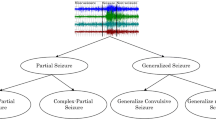Abstract
Nowadays, Epilepsy is one of the chronic severe neurological diseases; it has been identified with the help of brain signal analysis. The brain signals are recorded with the help of electrocorticography (ECoG), Electroencephalogram (EEG). From the brain signal, the abnormal brain functions are a more challenging task. The traditional systems are consuming more time to predict unusual brain patterns. Therefore, in this paper, effective bio-inspired machine learning techniques are utilized to predict the epilepsy seizure from the EEG signal with maximum recognition accuracy. Initially, patient brain images are collected by placing the electrodes on their scalp. From the brain signal, different features are extracted that are analyzed with the help of the Krill Herd algorithm for selecting the best features. The selected features are processed using an artificial alga optimized general Adversarial Networks. The network recognizes the intricate and abnormal seizure patterns. Then the discussed state-of-art methods are examined simulation results.






Similar content being viewed by others
References
Ahmadi N, Pei Y, Carrette E, Aldenkamp AP, Pechenizkiy M (2020) EEG-based classification of epilepsy and PNES: EEG microstate and functional brain network features. Brain Inform 7(1):1–22
Aljumah A, Siddiqui M (2016) Data mining perspective: prognosis of life style on hypertension and diabetes. Int Arab J Inform Technol 13:93–99
Andrzejak RG, Lehnertz K, Mormann F, Rieke C, David P, Elger CE (2001) Indications of nonlinear deterministic and finite-dimensional structures in time series of brain electrical activity: dependence on recording region and brain state. Phys Rev E 64(6):061907
Boonyakitanont P, Lek-Uthai A, Chomtho K, Songsiri J (2020) A review of feature extraction and performance evaluation in epileptic seizure detection using EEG. Biomed Signal Process Control 57:101702
Chaudhary UJ, Duncan JS, Lemieux L (2011) A dialogue with historical concepts of epilepsy from the Babylonians to Hughlings Jackson: persistent beliefs. Epilepsy Behav 21(2):109–114
Devi KU, Gomathi R (2020) Brain tumour classification using saliency driven nonlinear diffusion and deep learning with convolutional neural networks (CNN). J Ambient Intell Human Comput. https://doi.org/10.1007/s12652-020-02200-x
Fisher RS (2017) The new classification of seizures by the International League Against Epilepsy 2017. Curr Neurol Neurosci Rep 17(6):48
Gomathi P, Baskar S, Shakeel MP, Dhulipala SV (2019) Numerical function optimization in brain tumor regions using reconfigured multi-objective bat optimization algorithm. J Med Imaging Health Inform 9(3):482–489
Goodfellow I, Pouget-Abadie J, Mirza M, Xu B, Warde-Farley D, Ozair S, Bengio Y (2014) Generative adversarial nets. Advances in neural information processing systems. Springer, Berlin, pp 2672–2680
Hofmann EE, Haskell AE, Klinck JM, Lascara CM (2004) Lagrangian modelling studies of Antarctic krill (Euphausia superba) swarm formation. ICES J Mar Sci 61(4):617–631
Islam J (2019) Towards AI-assisted disease diagnosis: learning deep feature representations for medical image analysis, Dissertation, Georgia State University. https://scholarworks.gsu.edu/cs_diss/152
Jiao Z, Ming X, Cao Y, Cheng C, Wang SH (2019) Module partitioning for multilayer brain functional network using weighted clustering ensemble. J Ambient Intell Human Comput. https://doi.org/10.1007/s12652-019-01535-4
Korkmaz S, Babalik A, Kiran MS (2018) An artificial algae algorithm for solving binary optimization problems. Int J Mach Learn Cybern 9(7):1233–1247
Ledig C, Theis L, Huszár F, Caballero J, Cunningham A, Acosta, A, Shi W (2017) Photo-realistic single image super-resolution using a generative adversarial network. In: Proceedings of the IEEE conference on computer vision and pattern recognition, pp. 4681–4690
Mahmud M, Kaiser MS, Hussain A, Vassanelli S (2018) Applications of deep learning and reinforcement learning to biological data. IEEE Trans Neural Netw Learn Syst 29(6):2063–2079
Mera-Gaona M, López DM, Vargas-Canas R, Miño M (2020) Epileptic spikes detector in pediatric EEG based on matched filters and neural networks. Brain Inform 7:1–10
Mukherjee A, Mukherjee V (2015) Solution of optimal power flow using chaotic krill herd algorithm. Chaos Solitons Fractals 78:10–21
Paul Y (2018) Various epileptic seizure detection techniques using biomedical signals: a review. Brain Inform 5(2):6
Quintero-Rincón A, D’Giano C, Batatia H (2019) Seizure onset detection in eeg signals based on entropy from generalized gaussian pdf modeling and ensemble bagging classifier. Digital health approach for predictive, preventive, personalised and participatory medicine. Springer, Cham, pp 1–10
Rahman MA, Khanam F, Ahmad M, Uddin MS (2020) Multiclass EEG signal classification utilizing Rényi min-entropy-based feature selection from wavelet packet transformation. Brain Inform 7(1):1–11
Shakeel PM, Tobely TEE, Al-Feel H, Manogaran G, Baskar S (2019) Neural network based brain tumor detection using wireless infrared imaging sensor. IEEE Access 7:5577–5588
Siddiqui MK, Morales-Menendez R, Gupta PK, Iqbal HM, Hussain F, Khatoon K, Ahmad S (2020) Correlation between temperature and COVID-19 (suspected, confirmed and death) cases based on machine learning analysis. J Pure Appl Microbiol. https://doi.org/10.22207/JPAM.14.SPL1.40
Thurman DJ, Beghi E, Begley CE, Berg AT, Buchhalter JR, Ding D, Kroner B (2011) Standards for epidemiologic studies and surveillance of epilepsy. Epilepsia 52:2–26
Yan A, Zhou W, Yuan Q, Yuan S, Wu Q, Zhao X, Wang J (2015) Automatic seizure detection using Stockwell transform and boosting algorithm for long-term EEG. Epilepsy Behav 45:8–14
Yan J, Chen S, Deng S (2019) A EEG-based emotion recognition model with rhythm and time characteristics. Brain Inform 6(1):7
Zolghadr-Asli B, Bozorg-Haddad O, Chu X (2018) Krill Herd algorithm (KHA). Advanced optimization by nature-inspired algorithms. Springer, Singapore, pp 69–79
Acknowledgements
The authors extend their appreciation to the Deanship of Scientific Research at King Saud University, Saudi Arabia for funding this work through research group No. (RG-1439-053).
Funding
This research is funded by Zayed University, UAE, office of research under Grant No R17089.
Author information
Authors and Affiliations
Corresponding author
Additional information
Publisher's Note
Springer Nature remains neutral with regard to jurisdictional claims in published maps and institutional affiliations.
Rights and permissions
About this article
Cite this article
Abugabah, A., AlZubi, A.A., Al-Maitah, M. et al. Brain epilepsy seizure detection using bio-inspired krill herd and artificial alga optimized neural network approaches. J Ambient Intell Human Comput 12, 3317–3328 (2021). https://doi.org/10.1007/s12652-020-02520-y
Received:
Accepted:
Published:
Issue Date:
DOI: https://doi.org/10.1007/s12652-020-02520-y




